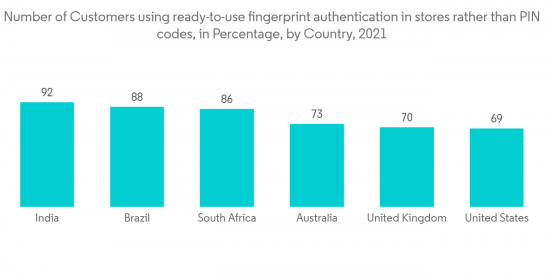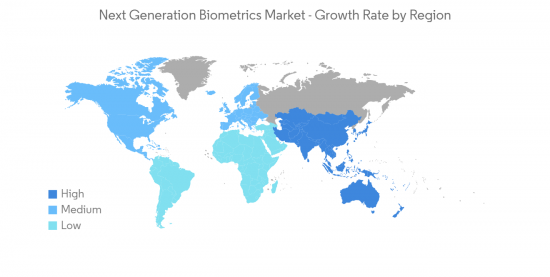 |
市场调查报告书
商品编码
1326282
下一代生物识别市场规模和份额分析 - 增长趋势和预测(2023-2028)Next Generation Biometrics Market Size & Share Analysis - Growth Trends & Forecasts (2023 - 2028) |
||||||
※ 本网页内容可能与最新版本有所差异。详细情况请与我们联繫。
下一代生物识别市场规模预计将从 2023 年的 429.6 亿美元增长到 2028 年的 942.3 亿美元,预测期内(2023-2028 年)复合年增长率为 17.01%。
下一代生物识别市场的主要趋势之一是商业话语的范式转变,转向更多的隐私和更少的安全威胁。最终用户越来越需要集成解决方案,而不是依赖传统方法。
主要亮点
- 由于恐怖活动增加以及敏感数据和信息盗窃行为增加,国家安全问题日益严重,预计下一代生物识别市场将出现强劲增长。例如,2022年8月,智利将引入自动生物识别系统(ABIS)来打击有组织犯罪。通过比较民警 (PDI)、民事登记处和国际刑警组织的生物识别记录,该系统可立即识别已识别的罪犯、非法移民和身份不明的死者。
- 全球范围内不断增加的身份欺诈正在限制全球市场的增长。据Onfido称,身份欺诈同比增加了43%,犯罪分子采用更复杂的技术,使用逼真的2D/3D面具和显示攻击(例如在屏幕上显示一个人的照片)来欺骗身份身份验证系统,导致复杂的欺诈行为增加了57%。由于十分之九的消费者能够轻鬆访问数字服务,欺诈者的机会就更大了。
- 下一代生物识别行业正受益于电子卡和生物识别护照的兴起。例如,哥斯达黎加计划于 2021 年 9 月和 2022 年推出生物识别护照。这种新护照是使用尖端安全技术创建的,以拒绝欺诈企图。它还符合国际民用航空组织製定的要求。在预测期内,这些进步可能会创造市场发展增长机会。
- COVID-19 的爆发显着增加了对非接触式生物识别解决方案的需求,尤其是在医疗保健领域,并对各行业造成了重大干扰和调整。先进的多因素和多模式生物识别解决方案因其准确性和对 COVID-19 社交距离规范的适用性而变得越来越重要。
- 企业必须避免使用指纹、掌纹和手钥匙扫描仪,以尽量减少身体接触和病毒传播。这些行为为面部识别设备和用户友好的虹膜扫描奠定了基础。这种流行病引发了非接触式生物识别技术的趋势,这些技术评估面部、步态和语音识别以进行准确的身份验证,这对市场增长是积极的,预计在预测期内将增长。
下一代生物识别市场趋势
银行和金融业增长最快的部门
- 各国央行正在推进生物识别认证的引入。Bank of America, JPMorgan Chase, Wells Fargo允许客户使用指纹登录手机银行。此外,银行呼叫中心还引入了语音识别技术来识别客户。下一代生物识别认证可以消除对密码的需求,从而提高客户满意度,从而增加银行业对生物识别技术的需求。
- 根据 Visa 2022 年 5 月进行的一项民意调查,86% 的用户热衷于在付款时使用生物识别技术来验证自己的身份。70% 使用生物识别技术的受访者表示它更简单,46% 的受访者表示它比凭证或 PIN 码更安全。因此,由于银行欺诈的增加,网上银行和移动支付中生物识别安全的采用预计将有助于市场增长。
- IDEMIA 表示,2021 年 7 月,作为全球生物识别解决方案先驱的印度银行业现在更加热衷于在后新冠时代部署安全实用的生物识别技术。IDEMIA致力于提供各种尖端的生物识别保护和交易解决方案。BFSI 领域这些新兴市场的发展预计将在未来几年推动下一代生物识别市场。
- 由于BFSI领域越来越多地使用数字技术,互联网金融和数字化运营近年来越来越受欢迎。许多银行现在使用生物面部识别技术通过 ATM 机访问账户,无需刷卡。例如,2022 年 5 月,MasterCard为实体店推出了一种生物识别支付方式,该方式依赖于面部识别生物识别技术,而不是智能手机、智能卡或记忆的 PIN 码。

预计亚太地区在预测期内将出现显着增长
- 该地区的市场预计新兴经济体将强劲增长,预计在预测期内将稳定增长。除了消费电子产品和政府部门外,随着下一代生物识别技术的应用,该地区的医疗保健行业预计也会增长。
- 由于该地区技术创新的进步以及生物识别设备的可负担性和广泛使用,预计该地区将实现增长。此外,下一代生物识别行业正在崛起,政府和多个商业部门利用这项创新来识别个人。
- 游戏零售、银行和金融行业以及医院等终端用户对生物识别技术的需求正在不断增加。这种需求对全国市场的扩张产生了重大影响。例如,2021 年 6 月,China Construction Bank (CCB) 与 IDEX Biometrics 合作,选择在其数字人民币计划中采用生物识别凭证。该银行此前为其数字人民币钱包提供了一款应用程序。得益于支持 NFC 的生物识别智能卡,用户无需智能手机即可使用加密货币。
- 亚太国家市场的扩张是由新兴经济体扩张、旅行兴趣增加以及物联网设备使用增加等因素推动的。例如,2021 年 11 月,“Mantra Softech”和北方邦政府签订了一项使用生物识别技术分配口粮的协议。此外,2021 年 12 月,作为“DIGI YATRA SCHEME”的一部分,印度政府引入了“面部识别技术”(FRT)用于旅行者登记。最近发生的这些事件预计将加速生物识别行业在该领域的扩张。
- 2022年9月,作为亚太地区持续增长的一部分,下一代身份验证平台Incode透露,它已与TOTM Technologies作为经销商合作,为印度尼西亚市场提供其身份解决方案Incode Omni。 。TOTM Technologies 致力于将 Incode 世界一流的安全且以客户为中心的生物识别解决方案引入印度尼西亚,从而扩大该地区的业务范围。因此,亚太地区的这些市场发展预计将在预测期内推动下一代生物识别市场。

下一代生物识别行业概述
下一代生物识别市场高度分散,众多市场参与者正在根据市场需求投资技术创新。此外,由于未来的预期需求,下一代生物识别市场竞争非常激烈。该市场的主要参与者包括IDEMIA, Fujitsu Limited, NEC Corporation, Thales Group, Siemens AG。
- 2022 年 9 月:全球领先的数字身份验证和身份验证供应商 Onfido 推出 Motion,这是一种领先的生物识别活性解决方案,可改进真实身份平台。Motion 已通过 iBeta 2 级认证,可提供流畅、安全且全面的消费者身份验证。
- 2022 年 8 月:IDEX Biometrics ASA 和 Realtime AS 开始战略合作,创建并商业化世界上第一张具有冷存储和数字财富钱包以及数字身份的 Web3 生物识别交易卡。符合EMV标准的一体化生物识别支付卡预计将于2023年上半年上市。
其他福利:
- Excel 格式的市场预测 (ME) 表
- 3 个月的分析师支持
目录
第 1 章 简介
- 研究假设和市场定义
- 调查范围
第二章研究方法论
第三章执行摘要
第四章市场动态
- 市场概况
- 市场驱动力
- 增长倾向电子护照项目
- 生物识别技术与智能手机的集成推动增长
- 市场製约因素
- 对侵犯隐私的担忧是增长的挑战
- 系统的高初始成本限制了增长
- 行业吸引力——波特五力分析
- 供应商的议价能力
- 买方议价能力
- 新进入者的威胁
- 替代品的威胁
- 竞争对手之间的竞争
- 技术快照
第五章市场细分
- 按解决方案类型
- 人脸识别
- 指纹认证
- 虹膜识别
- 掌纹认证
- 签名识别
- 其他解决方案类型
- 最终用户行业
- 政府
- 防御
- 旅行和出入境管制
- 家庭安全
- 银行和金融服务
- 卫生保健
- 其他最终用户行业
- 按地区
- 北美
- 欧洲
- 亚太地区
- 中东/非洲
- 拉丁美洲
第六章 竞争格局
- 公司简介
- IDEMIA
- NEC Corporation
- Fujitsu Ltd
- Siemens AG
- Thales Group
- Cross Match Technologies
- Fingerprint Cards AB
- Suprema Inc.
- RCG Holdings Limited
- Safran SA
第七章投资分析
第八章市场机会与未来趋势
The Next Generation Biometrics Market size is expected to grow from USD 42.96 billion in 2023 to USD 94.23 billion by 2028, at a CAGR of 17.01% during the forecast period (2023-2028).
One of the key trends witnessed in the next-generation biometrics market is a paradigm shift in business discourse toward more privacy and fewer security threats. The end-users are increasingly looking for integrated solutions rather than depending on conventional methods.
Key Highlights
- The next-generation biometric market is anticipated to grow at a significant growth rate due to the rising number of terrorist activities, coupled with the increasing theft activities on the part of crucial data and information that have raised concerns regarding national security. For instance, in August 2022, Chile is implementing an automatic biometric identification system (ABIS) to combat organized crime. By comparing the biometric records of the civil police (PDI), the civil registry, and Interpol, the system would instantaneously identify recognized criminals, illegal migrants, and the deceased who lack any identity.
- The rising identity fraud across the globe is restricting market growth globally. According to Onfido, Identity fraud rose 43% YoY, with sophisticated fraud increasing 57% as criminals employed smarter tactics, utilizing realistic 2D/3D masks and deploying display attacks (for instance, showing a picture of a person on a screen) to try to spoof verification systems. And with 9 out of 10 consumers comfortable accessing digital services, the opportunities for fraudsters are further increasing.
- The next-generation biometric industry benefits from the increase in electronic cards and biometric passports. Costa Rica, for example, in September 2021, is slated to launch its biometric passport in 2022. The new passport was created using the most advanced security technology to reject fraudulent attempts. It also complies with the demands the International Civil Aviation Organization sets forth. Throughout the projected term, these advances may generate growth opportunities for market development.
- The COVID-19 outbreak significantly increased demand for touchless biometrics solutions, particularly in the healthcare sector, and created substantial disturbances and adjustments in various industries. Advanced multifactor and multimodal biometrics solutions are becoming increasingly important due to their accuracy and conformance with COVID-19's social separation norms.
- Companies must refrain from using fingerprint, palm print, and hand-key scanners to minimize physical touch and virus transmission. These actions are laying the groundwork for facial identification equipment and user-friendly iris scanning, which will be applied in several contexts. The outbreak brought about a trend toward contactless biometric technologies that assess face, gait, and speech recognition for accurate identification, which benefitted the market growth and is expected to grow over the forecast period.
Next Generation Biometrics Market Trends
Banking and Financial Industry to be the Fastest Growing Sector
- Central Banks are rolling out biometric authentication. Bank of America, JP Morgan Chase, and Wells Fargo allow customers to log in to mobile banking via fingerprint authentication. Voice authentication is also deployed in bank call centres to identify customers. Next-generation biometric authentication can improve customer satisfaction by eliminating the need for passwords and increasing the demand for biometrics in the banking sector.
- A Visa poll from May 2022 found that 86% of users are eager to utilize biometrics to verify their identification while making payments. 70% of respondents who used biometrics said it was simpler to use them, and 46% said they were safer than credentials or PINs. Thus, increasing the adoption of biometric security for internet banking and mobile payments is expected to contribute to the market growth due to increasing banking fraud.
- According to IDEMIA, in July 2021, a pioneer in biometric solutions worldwide, the Indian banking industry is now more eager to implement safe and practical biometric technologies in the post-Covid era. IDEMIA is seeking to provide various cutting-edge biometric protection and transaction solutions. These developments in the BFSI sector are expected to propel next generation biometrics market over the coming years.
- Internet finance and digital operations have become increasingly popular over the past few years due to the increased use of digital technology in the BFSI sector. Many banks now use biometric facial recognition to access accounts through ATMs, eliminating the requirement to punch a card. For instance, in May 2022, Mastercard introduced a biometric payment method for physical establishments that relies on face recognition biometrics instead than smartphones, smart cards, or memorized PINs.

Asia-Pacific to Witness a Significant Growth Rate over the Forecast Period
- The market in the region is expected to witness significant growth in emerging economies, estimated to grow steadily over the forecast period. Apart from the consumer electronics and government sectors, the healthcare sector is expected to experience growth in the application of next-generation biometrics in this region.
- The region is expected to grow with innovation advancement and the region's widespread use of biometric devices at an affordable price. Additionally, the next-generation biometrics industry is increasing as the government and several business sectors use this innovation to identify individuals.
- The need for biometric identification technologies is rising among end-users, such as gaming retail, the banking and financial industry, hospitals, etc. This demand is having a substantial impact on the market's expansion nationwide. For instance, in June 2021, in conjunction with IDEX Biometrics, the China Construction Bank (CCB) chose to employ biometric credentials in its digital renminbi initiatives. The institution previously made available an app for digital yuan wallets. Users will not require a smartphone to utilize virtual currency owing to the NFC-enabled biometrics smart card.
- The rise of the market in the Asia Pacific countries is fuelled by factors including the economic development of developing nations, rising interest in travel, and increased use of IoT devices. For instance, in November 2021, "Mantra Softech" and the administration of Uttar Pradesh reached an agreement to distribute rations using biometrics. Furthermore, in December 2021. the Indian government implemented "Facial Recognition Technology" (FRT) for traveler registration as part of the "DIGI YATRA SCHEME." These recent events are anticipated to accelerate the expansion of the biometric industry in this area.
- In September 2022, as a continuation of its Asia Pacific growth, Incode, the next-generation identity confirmation platform, revealed that it partnered with TOTM Technologies as a distributor to provide identification solutions, Incode Omni, to the Indonesian market. By introducing world-class, safe, and customer-focused biometric solutions from Incode to the area, TOTM Technologies is dedicated to widening the scope of Indonesian businesses. Thus, these developments in the Asia-Pacific region are expected to propel the next-generation biometric market over the forecast period.

Next Generation Biometrics Industry Overview
The next-generation biometrics market is highly fragmented due to numerous market players investing in technological innovation aligned with the market need. Moreover, the next-generation biometric market is highly competitive due to the expected demand in the future. Some of the key players in the market are Idemia, Fujitsu Ltd., NEC Corporation, Thales Group, and Siemens AG.
- September 2022: Onfido, the top worldwide digital identity validation, and authentication supplier launched Motion, a cutting-edge liveness solution for biometrics that will improve its Real Identity Platform. Motion is iBeta Level 2 approved and offers smooth, secure, and inclusive consumer verification.
- August 2022: IDEX Biometrics ASA and Realtime AS launched strategic cooperation to create and commercialize the world's inaugural Web3 biometric transaction card with cold storing and digital property wallets, as well as digital identity. In the first half of 2023, the marketplace is predicted to get these all-in-one biometrics payment card that complies with EMV standards.
Additional Benefits:
- The market estimate (ME) sheet in Excel format
- 3 months of analyst support
TABLE OF CONTENTS
1 INTRODUCTION
- 1.1 Study Assumptions and Market Definitions
- 1.2 Scope of the Study
2 RESEARCH METHODOLOGY
3 EXECUTIVE SUMMARY
4 MARKET DYNAMICS
- 4.1 Market Overview
- 4.2 Market Drivers
- 4.2.1 Inclination of Growth toward E-Passport Program
- 4.2.2 Integration of Biometrics in Smartphones Driving Growth
- 4.3 Market Restraints
- 4.3.1 Fear of Privacy Invasion Challenging Growth
- 4.3.2 High Initial Cost of Systems Restricting Growth
- 4.4 Industry Attractiveness - Porter's Five Forces Analysis
- 4.4.1 Bargaining Power of Suppliers
- 4.4.2 Bargaining Power of Buyers
- 4.4.3 Threat of New Entrants
- 4.4.4 Threat of Substitute Products
- 4.4.5 Intensity of Competitive Rivalry
- 4.5 Technology Snapshot
5 MARKET SEGMENTATION
- 5.1 By Type of Solution
- 5.1.1 Face Recognition
- 5.1.2 Fingerprint Recognition
- 5.1.3 Iris Recognition
- 5.1.4 Palm Print Recognition
- 5.1.5 Signature Recognition
- 5.1.6 Other Types of Solutions
- 5.2 By End-user Vertical
- 5.2.1 Government
- 5.2.2 Defense
- 5.2.3 Travel and Immigration
- 5.2.4 Home Security
- 5.2.5 Banking and Financial Service
- 5.2.6 Healthcare
- 5.2.7 Other End-user Verticals
- 5.3 Geography
- 5.3.1 North America
- 5.3.2 Europe
- 5.3.3 Asia-Pacific
- 5.3.4 Middle East & Africa
- 5.3.5 Latin America
6 COMPETITIVE LANDSCAPE
- 6.1 Company Profiles
- 6.1.1 IDEMIA
- 6.1.2 NEC Corporation
- 6.1.3 Fujitsu Ltd
- 6.1.4 Siemens AG
- 6.1.5 Thales Group
- 6.1.6 Cross Match Technologies
- 6.1.7 Fingerprint Cards AB
- 6.1.8 Suprema Inc.
- 6.1.9 RCG Holdings Limited
- 6.1.10 Safran SA













